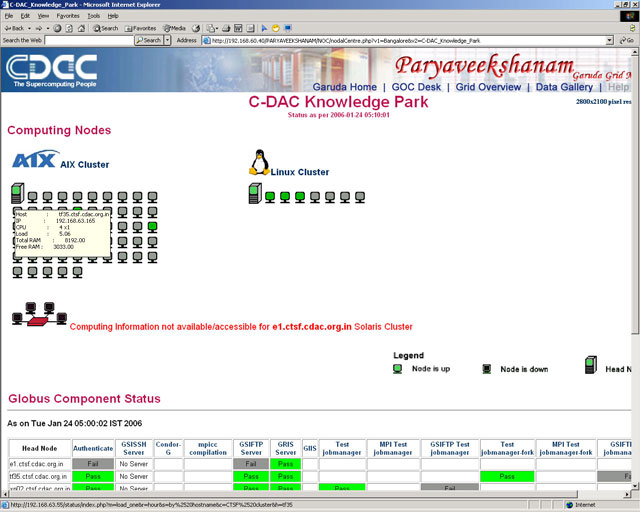The major components of GARUDA (Figure 1) include the computing resources, high-speed communication fabric, middleware & security mechanisms, tools to support program development, collaborative environments, data management and grid monitoring & management. Access portals and specialized problem solving environments provide a seamless user interface to the Grid.

In the initial phase, the PARAM4 Clusters at C-DAC labs in Bangalore, Pune, Hyderabad and Chennai will power the Grid. This provides a heterogeneous resource environment with clusters based on AIX, Solaris and Linux environments. The PARAM clusters are powered by PARAMNet5 interconnect and C-DAC's HPCC6 software. The PARAMNet system area network has 2.5 Gbps links and exports the Kshipra7 lightweight communication protocol conforming to Virtual Interface Architecture (VIA) and MPI Application Programming Interface. The HPCC software provides a complete solution for creating and executing parallel programs on UNIX clusters through high performance communication protocols and a rich set of program development, system management and software engineering tools. This software is available on AIX, Solaris and Linux cluster environments. As the project progresses, GARUDA partners are expected to contribute resources including specialized scientific instruments.
The GARUDA network is a Layer 2/3 MPLS Virtual Private Network (VPN) connecting select institutions at 10/100 Mbps with stringent quality and service level agreements. The multi-services network with a total backbone throughput of 2.43 Gbps, connects 17 cities (Figure 2) covering 45 research and academic institutions across the country. It is expected to support not only the traffic requirements of high performance computing applications but also other requirements like that of IP-based collaborative environments enabled through video conferencing and Access Grid.

A dedicated Grid monitoring and management centre at C-DAC, Bangalore helps in managing and monitoring all the components in the Grid. State-of-the-art display walls and advanced software like Paryaveekshanam (Figure 3), developed at C-DAC, help in effectively monitoring the health and utilization of various components of the Grid. A mobile agent framework for monitoring the Grid resources and also for automatic update of software releases is being explored.

Proposed research activities include exploring advanced network services, development of novel architectures, integration of network services into the Grid middleware, deployment of IPv6 and alternate protocols to overcome the shortcomings of IP over high-speed networks. This fabric is a pre-cursor to the next generation Gigabit network and is being deployed in collaboration with ERNET8 – a scientific society under the Department of Information Technology. A simulation model of the network is being developed to understand the impact of change in traffic profiles on the performance and in providing inputs to decide on the architecture of the fabric for the next phase of the project.






